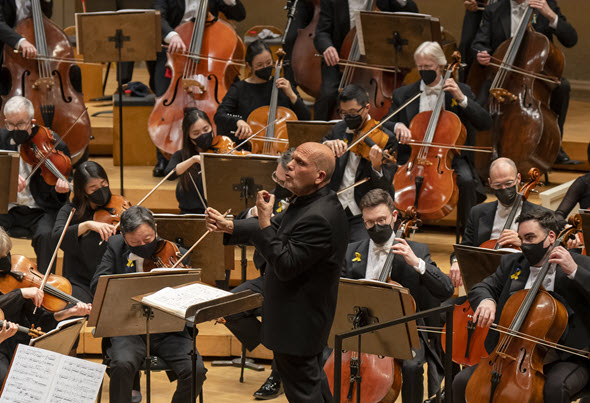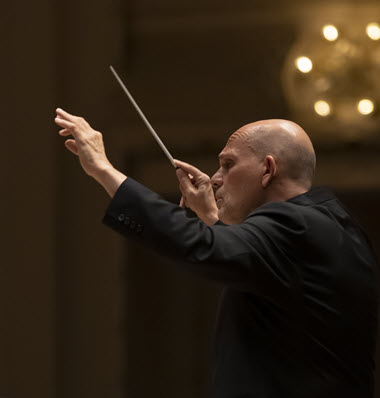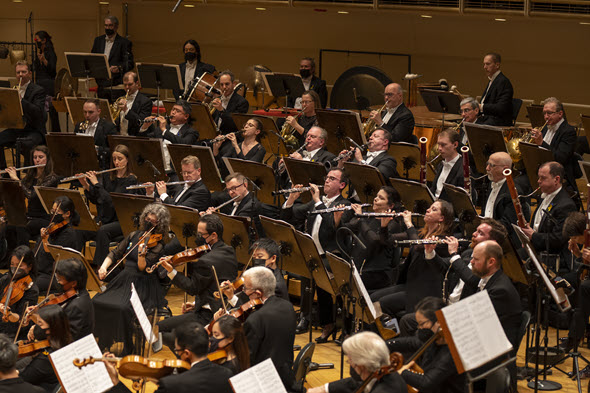Van Zweden paces Chicago Symphony across sweeping and desolate plain of Mahler Sixth
Review: Chicago Symphony Orchestra conducted by Jaap van Zweden, April 22 at Orchestra Hall.
By Lawrence B. Johnson
Gustav Mahler liked to say that in his symphonies he created whole worlds. Immoderate as that may sound, it’s at least true that his Sixth Symphony filled the whole stage at Orchestra Hall when the Chicago Symphony Orchestra performed the work April 22 with conductor Jaap van Zweden. Indeed, the sprawling 80-minute Sixth Symphony, the only work on the program, filled the whole weekend – with four performances rather than the typical three for CSO subscription programs. Like his works, Mahler’s popularity is vast.
The Sixth is an intriguing creature, or epic, or world: dark unto bleakness, pounding, stormy, but also masterful in both its organic monumentality and in its application of huge forces, the detail of its density. In truth, it’s a challenge for everyone in the hall: audience, musicians, conductor. The Chicago Symphony came to the Sixth from a great Mahler legacy dating back to the era of Georg Solti’s directorship. (Fritz Reiner didn’t conduct all that much Mahler and recorded only the radiant Fourth Symphony, chamber music writ large, whereas Solti and the CSO recorded all nine of the completed symphonies.) Van Zweden, music director of the New York Philharmonic, brought his own formidable credentials: He was concertmaster of the Amsterdam Concertgebouw Orchestra under Bernard Haitink, one of the foremost Mahler conductors of the last half-century.
In every aspect, this was a titanic meeting of minds and music. And it was an Olympian profile, fierce and imposing, that Van Zweden chiseled into the Sixth. What this conductor sought, first to last, was the overwhelming grandeur of Mahler’s music and its inexorable, single-minded drive toward an abyss of tragedy. The Sixth begins in A minor and ends there, the only such example in the entire panoply of Mahler’s symphonies. Van Zweden plunged into it with unswerving purpose.
I have seen the Chicago Symphony lashed and driven by conductors. This was not such an example. Within the rather narrow emotional range of his interpretation, Van Zweden displayed finesse and nuance. It was not all of a relentless piece. Still, in its ever-forward thrust, moments of repose or quiet in the storm were few. How this would go become clear in the opening movement’s stentorian march; even where the music backed off for breath, Van Zweden soldiered on.
How the symphony’s two middle movements should line up has been debated since, well, Mahler himself couldn’t decide. Did he want the again urgent, clangorous Scherzo to immediately take up the like character of the first movement before the respite of the slow movement – or should he place the slow movement second and recapture the original ferocious spirit in chapter three? Mahler’s first creative impulse was to place the Scherzo second, but then he reversed himself. Van Zweden sides with the great majority of today’s conductors who find more compelling musical and dramatic argument in Mahler’s first thought, and proceed directly from the immense tumult of the opening movement to the Scherzo. At least the Scherzo offers the relief of lyric, even sweetly rustic interludes, though Van Zweden showed little inclination to dally long over those, either.
The conductor’s reluctance to just let the music bloom became most problematic in the slow movement, which possesses an inherent tenderness reminiscent of the Adagietto of Mahler’s Fifth Symphony. But Van Zweden was not in an indulgent vein. While he hardly plowed through the lyrical third movement, he perhaps leaned into it, as if to make it of a piece with the Sixth’s generally fraught bearing.
From the start, an outsized version of the Chicago Symphony – eight French horns amid phalanxes of woodwinds, trumpets and trombones, plus a formidable percussion battery – played with equal parts of power and precision. It was beautiful in the way that Shakespeare’s “Macbeth” is beautiful in its grim hopelessness. In the Sixth’s grand-scaled finale, almost no light enters. The tunnel is long, and dark to the very end. This remarkable crowning essay is also phenomenally complex, an exercise in ensemble virtuosity in the nth degree, much like the final movement of the Fifth Symphony; but whereas the latter is all brilliance, the long goodbye of the Sixth is all about Fate spreading calamity and proclaiming an unhappy ever-after. Van Zweden left nothing un-churned; it was a withering experience, a great sound and fury auguring death, if perhaps not transfiguration.
But even as he labored at the Sixth Symphony, Mahler was planning the more sympathetic Seventh, which the Berlin Philharmonic will bring to Orchestra Hall on Nov. 16 under the baton of its music director, Kirill Petrenko. And the Fifth Symphony likewise shows up next season in CSO concerts Feb. 16-18, 2023, led by Klaus Mäkelä. Thus Mahler-mania continues unabated.





